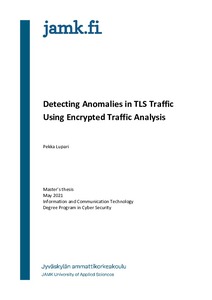Detecting Anomalies in TLS Traffic Using Encrypted Traffic Analysis
Lupari, Pekka (2021)
Lataukset:
Lupari, Pekka
2021
All rights reserved. This publication is copyrighted. You may download, display and print it for Your own personal use. Commercial use is prohibited.
Julkaisun pysyvä osoite on
https://urn.fi/URN:NBN:fi:amk-2021060213399
https://urn.fi/URN:NBN:fi:amk-2021060213399
Tiivistelmä
Subject of research was assigned by Cinia Oy. Cinia is a Finish company providing network, software and cyber security services and solutions. Subject was delineated to detection of anomalies in Transport Layer Security (TLS). Mitigation, response and forensics activities were out of scope.
Primary objective was to gain understanding of methods and tools how one can detect
anomalies in TLS encrypted traffic without decrypting it and how opensource products
could be utilized. Another, more practical, objective was to investigate how two different
commercial products, SensorFleet and LogPoint, could be combined and utilized as an
Encrypted Traffic Analysis (ETA) solution. Opensource ETA solution, based on Security
Onion and RITA systems, was used as a reference.
Research was made using qualitative methods and analyzing was ongoing process during
the whole research. First, theoretical data from books, research papers, web articles and
videos were analyzed by researcher and then applied in testing phase. Results from tests
was analyzed and followed by conclusions.
Primary objective was to gain understanding of methods and tools how one can detect
anomalies in TLS encrypted traffic without decrypting it and how opensource products
could be utilized. Another, more practical, objective was to investigate how two different
commercial products, SensorFleet and LogPoint, could be combined and utilized as an
Encrypted Traffic Analysis (ETA) solution. Opensource ETA solution, based on Security
Onion and RITA systems, was used as a reference.
Research was made using qualitative methods and analyzing was ongoing process during
the whole research. First, theoretical data from books, research papers, web articles and
videos were analyzed by researcher and then applied in testing phase. Results from tests
was analyzed and followed by conclusions.
